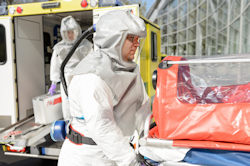What Should Employers Do?
Risk Levels and Respiratory Protection
This brief summary explains how workplace tasks and settings influence respiratory risk and when stronger respiratory protection may be needed.
Risk levels: Jobs are grouped by exposure risk (lower, medium, high, very high) depending on frequency/proximity of contact with people who may be infected and the presence of aerosol-generating procedures. Higher risk jobs require stronger controls.
Respirators and Fit-Testing: For high/very-high risk tasks (e.g., aerosol-generating procedures in healthcare), follow OSHA/CDC guidance for respiratory protection programs, including medical evaluation, fit-testing, and training. For general workplace settings, provide well-fitting high-quality masks during high-risk periods and for workers at higher risk of severe illness.
To learn more about OSHA's respiratory protection requirements, visit OSHAcademy's course 756: Respiratory Protection, or OSHA's respiratory protection overview page.
Knowledge Check Choose the best answer for the question.
3-6. What determines a job's respiratory risk level in the workplace?
You forgot to answer the question!

